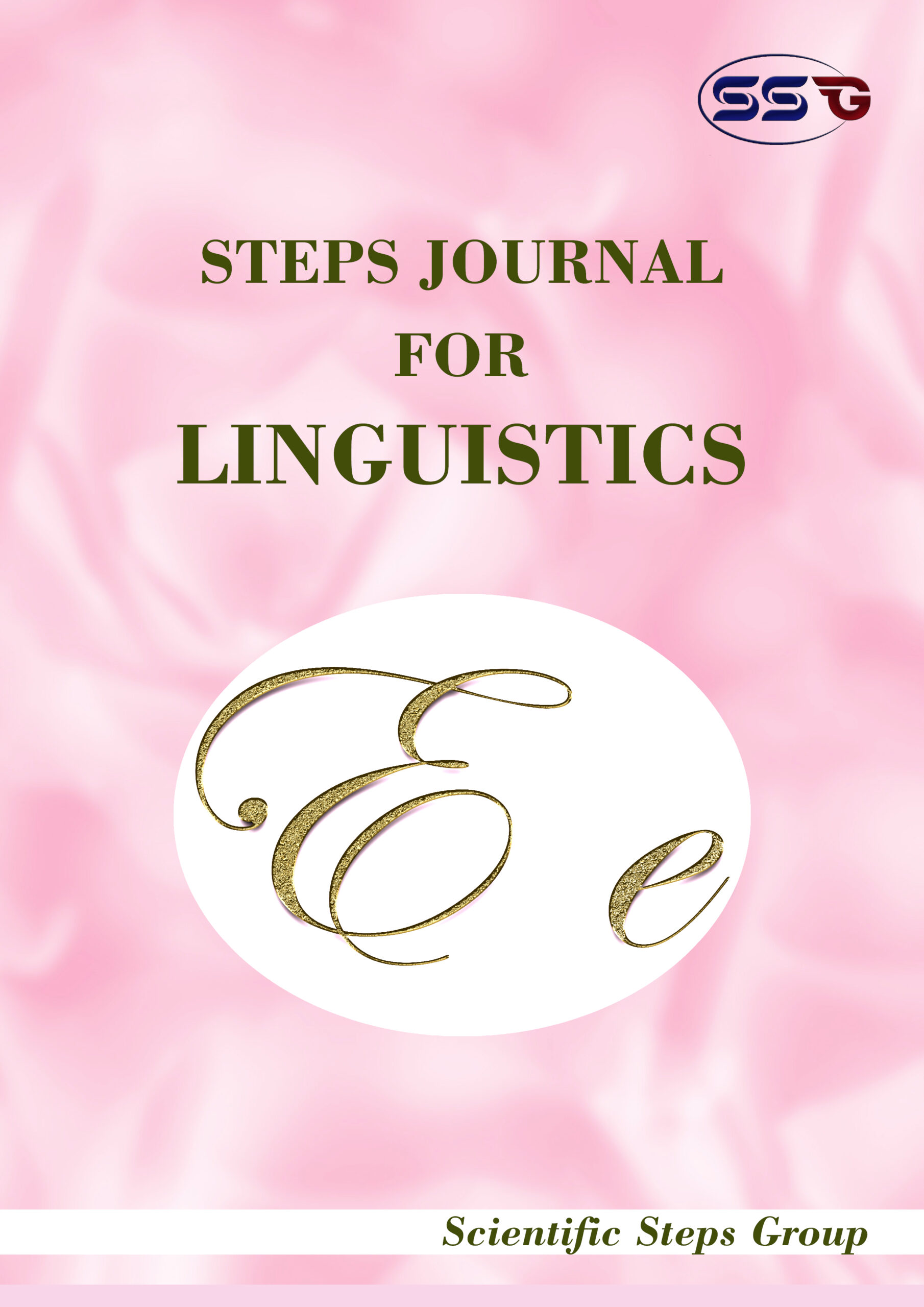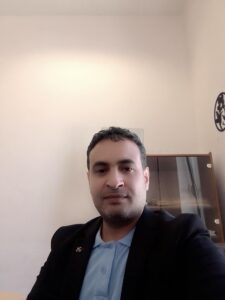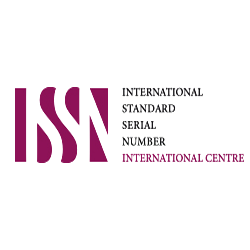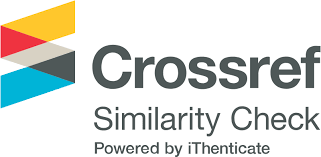
STEPS JOURNAL for LINGUISTICS is an international, scientific, peer-reviewed, open access journal published quarterly online by SSG.
STEPS JOURNAL for LINGUISTICS is concerned with all branches of theoretical linguistics. Preference is given to original research articles which present analyses or generalizations based on sound empirical work, which results in making a clear contribution to current debate in theoretical linguistics. Papers should be accessible to non-specialist linguists with an interest in the paper’s topic. The language of submission and publication is English.

STEPS JOURNAL for LINGUISTICS publishes articles addressing research questions of current or general relevance that make a significant contribution to our understanding of human language as a system of communication or a cognitive, social and historical phenomenon. This includes aspects of linguistical organization (phonetics, phonology, morphology, syntax) as well as meaning and use (semantics, pragmatics, discourse analysis). Studies may deal with linguistic systems as instantiated in different cultures and their communities (e.g. psycholinguistics, sociolinguistics). The focus may be on one or multi-languages, the perspective may be synchronic or diachronic, the methodology may be qualitative or quantitative, and the approach may be exploratory or confirmatory. The journal aims to improve the linguistic power of the language and consolidate of the national language communicative tool available to speakers.
STEPS JOURNAL for LINGUISTICS covers significant developments in the field of linguistics, including:
Phonetics
Phonology
Morphology
Syntax
Semantics
Pragmatics
Sociolinguistics
Psycholinguistics
Discourse Analysis
Neurolinguistics
Translation
Evolution of Language
Applied Linguistics

Dr. Rula Tarawneh, Ph.D
Assistant Professor at Al-Balqa Applied University, Amman, Jordan.

Dr. Dr. SAMIA AZIEB, Ph.D
Associate Professor of Theoretical Linguistics at Najran University, kingdom of Saudi Arabia.

Dr. Sami Al-Khawaldeh, PhD.
Assistant professor at English Language and Literature Department – Arab Open University, Amman, Jordan.

Dr. Slimane Boukhentache, PhD.
Associate Professor of Theoretical Linguistics at Mohamed Seddik Ben Yahia University, Algeria.
Dr. Nora Majed BinSultan, PhD.
Assistant Professors at College of Language Sciences at King Saud University, Saudi Arabia.
 Dr. Marine Shalaby., PhD
Dr. Marine Shalaby., PhD
Assistant Professor at The Arab Open University, Kuwait Branch
All articles published in STEPS JOURNAL for LINGUISTICS are published in full open access. An article processing charge (APC) of 650 USD applies to papers accepted after peer review.
This article processing charge is to cover the costs of peer review, copyediting, typesetting, long-term archiving, and journal management.
Local VAT or Sales Tax will be added if applicable.
Submitted papers should be well formatted and use good English. Authors may use SSG’s English editing service prior to publication or during author revisions.
You can read more about Article Processing Charges (APC) of SSG’s Journals.
1– Check if your article is a good fit for your target journal by reading the aims & scope of the journal, and look at recently published articles.
2- Select the type of your article
– Article/Research Article/Original Research – provide a complete description of original research findings.
– Letters/Research Letters/Short Reports/Communications – are short descriptions of research findings.
– Review Articles – do not cover original research but provide a comprehensive summary of a topic by identifying and summarizing the results of original articles on the topic.
Types of review articles include, but are not limited to:
Scoping review – a preliminary assessment to identify the nature and extent of review.
Systematic review – a comprehensive review in response to a research question that aims to identify, select and synthesize all of the published research.
Critical review – seeks to identify the most important items and often results in a hypothesis or model.
Literature review – looks to review what has been recently published and allows for building on previous works and identifying gaps.
Meta-analysis – takes data from multiple studies of a similar nature and combines them to provide more precise effect of the results.
– Case reports – a descriptive, exploratory or explanatory analysis of a person, group or event.
– Viewpoints/Opinions – essays presenting opinion on a specific topic (sometimes controversial).
3- Please at least use a plagiarism checker before the author submits the manuscript. A maximum of 20% similarity rate is allowed in Scientific Steps Group journals.
You can find more information about publishing ethics, including plagiarism, on our Publication Ethics section.
4- Use the Microsoft Word Template to prepare your manuscript.
5- Submission:
Manuscripts should be submitted online. The submitting author, who is generally the corresponding author, is responsible for the manuscript during the submission and peer-review process. The submitting author must ensure that all eligible co-authors have been included in the author list and that they have all read and approved the submitted version of the manuscript. To submit your manuscript, register and log in to the submission website. Once you have registered, click here to go to the submission page. All co-authors can see the manuscript details in the submission system, if they register and log in using the e-mail address provided during manuscript submission.
5- Manuscript presentation:
The manuscript should contain sections such as Title, Abstract, Introduction, Materials & Methods, Results & Discussion, Conclusion, Acknowledgement and finally References. No other subheadings should be given in the manuscript.
– Manuscripts must be clearly written in English and should be typewritten with a font Times New Roman of 12 pt, leaving adequate margins on all sides to allow reviewers’ remarks. Please 1.5 space for all materials. The length of the paper including text, tables and figures should not exceed 25 pages. Place all tables and figures within the text.
– Manuscripts must include the sections listed below in the order they are presented.
– Do not incorporate any footer or headers in your submission.
– Turn off Track Changes.
– Do not include line numbers.
– Do not include notes or footnotes.
– Do not number the titles or on lines.
– The final manuscript should not be more than 3MB.
– Persons who have significant contributions to conducting the research must not be excluded from the authors list and persons without having any contribution should not be included as authors.
– No Plagiarism but rephrases or rearticulates giving proper reference.
– Be cautious about the novelty and copyrights of others.
The title page should contain the title of the article, the full names of authors and institutional full addresses for all authors and the email of the corresponding author. Abstract and Keywords should be included.
A good title should contain the fewest possible words that adequately describe the contents of a paper. The title should be:
– Informative, meaningful & specific (not vague).
– Neither too short nor too long.
– Must be chosen with extreme care since it will be read by thousands of people while a few will go thru the entire paper.
– Words like ‘studies on’, ‘investigation on’ etc. should be avoided.
– Don’t USE unnecessary jargon, uncommon, abbreviations, ambiguous terms, or unnecessary detail, Focus on part of the content only.
Should provide the full name of all authors as Maya Razvy.
Should provide institutional full address for all assigned authors of the research findings as The Department, University Name, City, Country.
The name and email address of the corresponding author should also be included, mentioned on the corresponding author by marking star (*). The corresponding author is fully responsible for any disputes arising due to the publication of his/her manuscript.
For original investigations and brief reports, the abstract is limited to 250 words. The abstract should not contain any undefined abbreviations or references or exaggerated conclusions. A good abstract should (i) state the principal objectives and scope of the investigation, (ii) describe the methodology employed, (iii) summarize the results and (iv) state the principal conclusion.
Keywords should be very selective and appropriate with 5 keywords. While choosing keywords, imagine you are looking for your article in a certain database. Keywords are important for indexing: they enable your manuscript to be more easily identified and cited. Avoid uncommon abbreviations and general terms.
Original Investigations and Brief Report contain the section of Introduction, Literature Review, Research Methodology, Results and Discussion (or Results and Discussion).
Provide the necessary background information to put your work into context. The introduction should provide within 3-4 paragraphs based on the type or category of information presented with the motivation and aims of the study.
Don’t include:
– Describe methods, results or conclusions other than to outline what was done and achieved in the final paragraph.
– Description of how the data will be collected and analyzed.
– In brief terms, what was achieved?
– An extensive review of the field.
– Cite disproportionately your own work, work of colleagues or work that supports your findings while ignoring contradictory studies or work by competitors.
Reviewing previous studies which have been conducted on the same topic of your paper, and trying to link the results of these studies with the results of your study.
This section should provide detailed information about the sample or the population, research variables, research procedures, how the data have been collected and analysed. The number of methodology subsections can be adjusted.
Note:
● Please give an appropriate *sub-heading for each of the categories or methods used or procedure, study areas, analysis etc.
● Write most of this section in the past tense using passive voice. Do not include any results.
It is the most significant part of a paper. The Results section presents the experimental data to the reader and is not a place for discussion or interpretation of the data. The data itself should be presented in tables and figures. Introduce each group of tables and figures in a separate paragraph where the overall trends and data points of particular interest are noted. You may want to indicate the placement of a particular table or figure in the text. For experimental studies, key statistics such as the number of samples (n), the index of dispersion (SEM, SD) and the index of central tendency (mean, median or mode) must be stated without reference. Include any statistical analysis that was performed and make sure to indicate specific statistical data, such as p-values.
Give an appropriate sub-heading based on the parameters you studied to consider bellows matters.
– It should be short but clearly represented without wordiness.
– No discussions should be included here.
– Use Tables and Figures to organize all the data systematically: Tables to show exact values; Figures to show trends or relationship effects.
– Figures and Tables should be easy to understand without the reader having to refer to the text.
– Do not include both a Table and a Figure showing the same information.
– Textual representation mentioning the key findings must be provided with each table and the figure uses different tenses while giving different information in the result section. e.g. i) Something has been done during the study, present in past tense ii) Something in the paper itself (Table, Figure) present in the present tense.
Note:
● Presented each table and figure in the paper must be referred to in the results section without reference.
The discussion section, often the most difficult to write, should be relatively easy if the previous suggestions have been followed. In particular, look to the last paragraph of the introduction. If the work has characterized a phenomenon by studying specific effects, use the results to describe each effect in separate paragraphs. If the work has presented a hypothesis, use the results to construct a logical argument that supports or rejects your hypothesis. If the work has identified three main objectives for the work, use the results to address each of these objectives. A well-defined study that is described in the Introduction, along with supporting results that are presented in the Results section, should ease the construction of the Discussion section. Begin the Discussion section with a brief paragraph that again gives an overview of the work. Summarize the most important findings and, if applicable, accept or reject the proposed hypothesis. Next, identify the most interesting, significant, and remarkable findings that were presented in the Results section, and contrast these findings in light of other studies reported in the literature. It is often informative if a discussion of the potential weaknesses of the interpretation is also included. Finally, at the end of the Discussion section, consider the other works in the literature that address this topic and how this work contributes to the overall field of study.
Finalize the discussion section according to the following criteria –
– Try to present the principles, relationships and generalization shown by the results. Discuss, and do not recapitulate the results.
– Point out any exceptions or any lack of correction, and define unsettled points.
– Show how your results and interpretations agree (or contract) with previously published works.
– Discuss both theoretical implications, as well as practical applications.
Note:
● The author should be more focused on the justification of the results. The most important part of the discussion is the justification of your own findings not comparing your findings to previous reports.
It is important to include the practical implications of your research in the Conclusions chapter, discussing what the implications are for practitioners, companies etc. Again, first introduce the work and then briefly state the major results. Then state the major points of the discussion. Finally, end with a statement of how this work contributes to the overall field of study. The Conclusions section can be written up by using the following structure.
Introduction, Results, Significance of the research implications, Limitations, Recommended topics for further study.
Note:
● Author should present conclusion in one or two paragraphs with the whole maters.
Provide a brief statement acknowledging the efforts of any participants or consultants who are not included as authors of the manuscript. State all of the funding sources for the work, ensuring that the statement adheres to the guidelines provided by the funding institution. Acknowledgements of people, grants, funds, etc. should be placed in a separate section before the References.
Include all references that have been cited in the text. The references should be well considered so that they contain all key sources in the field as well as previous studies that support or motivate the present work. However, do not include extraneous references in an effort to simply cite particular authors or journals. It may be appropriate to cite previous publications from your own laboratory. References of the manuscript using APA (7th edition) style.
Journal Article
Afrianto. (2018). Being a Professional Teacher in the Era of Industrial Revolution 4. 0: Opportunities, Challenges and Strategies for Innovative Classroom Practices. English Language Teaching and Research, 2(1), 1-13.
Albantani, A. M., & Madkur, A. (2017). Musyahadat Al Fidyu: Youtube-Based Teaching and Learning of Arabic as Foreign Language (AFL). Dinamika Ilmu, 17(2), 291-308.
Book
McKibbin, B. (2007). Deep economy: The Wealth of Communities and The Durable Future. New York: Times Book/Henry Hold and Co
Panitch, L., & Gindin, S. (2012). The Making of Global Capitalism: The Political Economy of American Empire. London: Verso.
Book Chapter
Pigg, K. E., & Bradshaw, T. K. (2003). Catalytic Community Development: A Theory of Practice for Changing Rural Society. In D. L. Brown & L. E. Swanson (Eds.), Challenges for Rural America in The Twenty-First Century (pp. 385-396). Pennsylvania State University Press.
Regulations and Laws
Law Number 23 of 2011 concerning Zakat Management. November 25, 2011. State Gazette of the Republic of Indonesia Year 2011 Number 115. Jakarta.
Law Number 5 of 1984 concerning Industry. June 29, 1984. State Gazette of the Republic of Indonesia Year 1984 Number 22. Jakarta.
Thesis
Choiri, A. (2021). Pemberdayaan Pemulung Melalui Pengelolaan Sampah Plastik di Medayu Utara Rungkut Surabaya [Thesis]. UIN Sunan Ampel Surabaya, Surabaya.
Erizal, Y. (2011). Analisa Pelaksanaan Kemitraan Anak Angkat Bapak Angkat (ABA) dalam Usaha Agribisnis Kelapa Sawit di PT. GMP Kec. Pasaman Kabupaten Pasaman Barat [Thesis]. University if Andalas, Padang.
Internet Sources
Jenkis, R. (2018, January 7). Generation Z vs. Millennials: The 8 Differences You Need to Know. HR Daily Advisor. Retrieved from https://hrdailyadvisor.blr.com/2017/09/25/generation-z-vs-millennials-8-differences-need-know/
Maritime Security Agency of the Republic of Indonesia. (2021, June 25). Amerika Serikat dan Indonesia Bangun Pusat Pelatihan Maritim. Maritime Security Agency of the Republic of Indonesia. Retrieved from https://bakamla.go.id/publication/detail_news/amerika-serikat-dan-indonesia-bangun-pusat-pelatihan-maritim.
The authors must ensure that before submitting the manuscript for publication, they have taken care of the following matters:
– The title page should contain the full title, name of the author/co-authors, their designation & institutions they are affiliated with an email address for future correspondence.
– Abstract in structured format up to 250 words.
– References are mentioned as stated in the Instruction to Authors section.
– Make sure for Headings of Tables, their numbers and Captions of illustrations. Don’t repeat the information.
– Photographs illustrations with high resolution and their captions.




An independent academic publisher with an editorial team including many of the top researchers in the world. SSG publishes research, review, and case report articles in double-blind, peer-reviewed, open access scientific and academic journals.
Copyright © 2025 Scientific Steps International Publishing Services LLC (Dubai – United Arab Emirates)